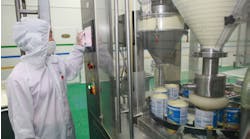What is it with wheat? More people are fed by rice, oats are more nutritious and corn is higher yielding, yet wheat remains top of the crops — the most widely grown and traded cereal on earth.
The answer, according to professor Grant Campbell of the school of chemical engineering and analytical science at Manchester University, Manchester, U.K., has to do with bubbles.
Speaking in May to an audience of chemical engineers, scientists and students, Campbell focused on bubbles and bread during his acceptance speech for the Frank Morton Medal. Presented by Institution of Chemical Engineers, Rugby, U.K., this annual award recognizes outstanding services to chemical engineering.
“Wheat is unique in that it is the only cereal that can give us raised bread. When you mix wheat flour with water and salt and yeast, you create a dough that can trap the carbon dioxide gas produced by the yeast, such that the dough piece rises. And then when you bake this, you have nice light bread. No other cereals let you do this,” said Campbell. He described his research into how to create and control the aerated structure of bread. For example, mixing dough at twice atmospheric pressure gives a nice, open structure in the final bread. Mixing under a partial vacuum leads to smaller gas cells in the bread and a finer crumb structure. In other words, a firmer, but smaller loaf that makes slicing for sandwiches much easier.
“So altering the mixing conditions alters the final bread structure — that’s easy to demonstrate. Understanding exactly how is much more difficult,” Campbell added.
Basic research into this is being carried out at the Campden & Chorleywood Food Research Association, Chipping Campden, U.K., where medical tomography technology is being used to better understand bubble behavior in bread.
Understanding how bubbles behave at a fundamental level helps us to understand how they behave in bread, Campbell said. While nutritionists are agreed that increasing our consumption of dietary fiber would give enormous health benefits, most people still prefer white bread because it has a more appealing aerated structure than wholemeal bread. The problem is that bran damages the aerated structure of bread — to put it simply, bran pops bubbles.
Understanding bubble behavior may help with this.
One solution, he said, is to pre-treat the bran with a suitable detergent, to create a type of bran that is capable of giving nice, well-risen, palatable bread that people would actually eat.
“That’s an idea that we’re currently trying to work on, but it illustrates how a fundamental understanding of bubble behavior can translate into practical benefit in making better bread — in this case, healthier bread.”
Moving onto the relationship between wheat and biofuels, Campbell touched on the challenges ahead — not least the huge rise in the grain’s price being driven by booming economies in India and China, rising oil prices, and the bad weather all over the world that has affected agricultural yields.
“There’s an urgency to replace oil with alternative energy sources, because of climate change, but at the moment it’s simply not economically competitive to produce ethanol from wheat [in the U.K.]. The key to it being economically competitive to ferment ethanol to wheat is to produce alongside the ethanol a range of other valuable byproducts.”
Noting that chemical engineers have an essential role to play in creating biofuel options, Campbell then described his department’s work on a systems approach using arabinoxylan (AX) extraction from wheat, co-produced with bioethanol: “AX could be a bread ingredient, so this again links back to bread.”
Campbell began academic life as a food technologist, discovering chemical engineering when he did the engineering part of his degree: “If I had my time again, I’d study chemical engineering for my first degree and then move into the food area, rather than the other way round. But by coming from food into chemical engineering, I have an appreciation of the power of chemical engineering that perhaps the physicists and chemists and mathematicians — and even the chemical engineers — don’t always have.”
To conclude, he quoted Socrates: “No man qualifies as a statesman who is entirely ignorant of the problems of wheat.” Or, in his own words: “In the future, no person will qualify as a process engineer who is entirely ignorant of the potential of cereals.”

